Australian Indigenous languages
Designing Future-Proof Language Programs for Indigenous Australian Communities
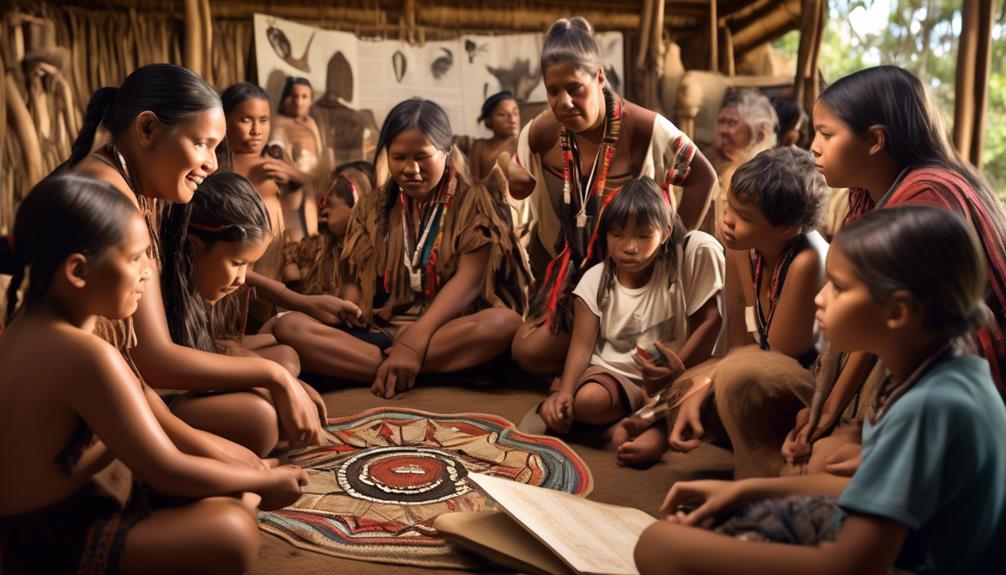
Creating language initiatives for Indigenous Australian communities involves facing a distinct set of obstacles that necessitate thoughtful deliberation and creative approaches. As we tackle the intricacies involved in maintaining and rejuvenating Indigenous languages, it’s clear that a universal strategy falls short.
The dynamic nature of Indigenous languages, coupled with the diverse cultural contexts and historical legacies, necessitates a thoughtful and adaptable framework for language program development. In exploring this topic, we will uncover the crucial elements that contribute to the sustainability and effectiveness of future-proof language programs for Indigenous Australian communities, ultimately shaping the course of language preservation efforts in the context of cultural empowerment and identity.
Key Takeaways
- Indigenous language revitalization is crucial for preserving cultural heritage, knowledge, and diversity within Indigenous communities.
- Successful CALL programs for language preservation require collaboration with Indigenous communities and a focus on spoken language.
- Culturally responsive approaches, which incorporate Indigenous worldviews and respect intellectual property rights, are essential for language revitalization efforts.
- Empowering Indigenous communities through tailored language programs, leadership roles, and access to digitized data and technological tools is key to the sustainability of language initiatives.
Importance of Language Preservation
Preserving Indigenous languages is vital for safeguarding cultural heritage and nurturing the well-being of Indigenous communities. Indigenous language revitalization isn't just about words; it's about preserving entire worlds of knowledge, traditions, and ways of life.
When we support Indigenous languages and cultures, we aren't only preserving words; we're safeguarding traditional knowledge that has been passed down through generations. Language preservation is crucial for maintaining the rich cultural and biological diversity that exists within Indigenous communities.
By revitalizing Indigenous languages, we can contribute to the well-being and empowerment of Indigenous communities, ensuring that their cultural values and human rights are upheld. These languages aren't just a means of communication; they're vessels of history and identity.
Preserving Indigenous languages isn't just an act of preservation; it's an investment in the future of Indigenous cultures and identities. It's a way of honoring and respecting the unique and invaluable contributions of Indigenous communities to our shared human experience.
Challenges in Program Development
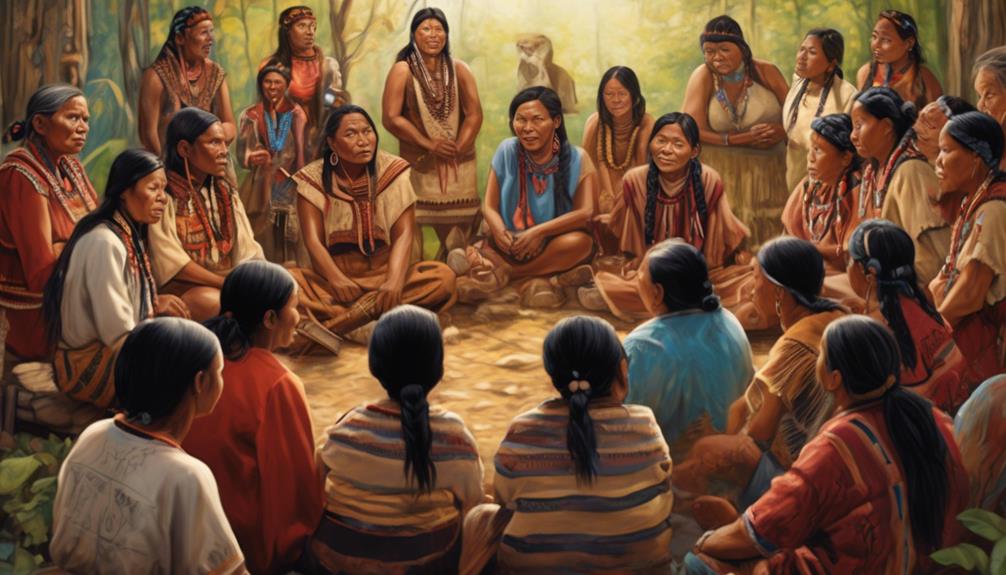
Despite persistent efforts in Indigenous language revitalization, the development of effective CALL programs for these languages faces significant challenges. This reality is a result of several complex factors that demand careful consideration and strategic planning.
These challenges include:
- Linguistic Colonization: The historical imposition of dominant languages has led to the marginalization and suppression of Indigenous languages, contributing to language loss and a decline in intergenerational transmission.
- Prioritizing Spoken Language: Effective CALL programs must prioritize spoken language over written forms, as many Indigenous languages are primarily spoken and have limited written traditions.
- Collaboration with Indigenous Communities: Developing successful CALL programs requires a design-based research approach that involves close collaboration with Indigenous Peoples, respecting their knowledge and perspectives.
- Community Involvement and Participatory Action Research: Utilizing existing digitized data for CALL programs necessitates community involvement and participatory action research to ensure the programs are culturally relevant and responsive to community needs.
These challenges underscore the need for a holistic and community-driven approach in the development of future-proof language programs for Indigenous Australian communities.
Culturally Responsive Approaches
Implementing culturally responsive approaches in language programs for Indigenous Australian communities requires a deep understanding of traditional knowledge systems and a commitment to collaboration with Indigenous communities and co-researchers. By prioritizing spoken language over written language, these approaches honor local languages and consider the unique needs and cultural contexts of Indigenous learners. They seek to address the marginalization of Indigenous communities by incorporating Indigenous worldviews into the design of language programs.
Collaboration with Indigenous communities and co-researchers is essential to develop practical outcomes for language revitalization. These approaches also require innovative and flexible design principles that address power imbalances, promote self-determination, and respect Indigenous intellectual property rights.
Furthermore, culturally responsive approaches aim to develop effective strategies that preserve and revitalize Indigenous languages while respecting cultural rights and promoting sustainability. As we strive to serve Indigenous communities through multicultural and multilingual education, it's imperative to embrace these approaches and work in partnership with Indigenous peoples to ensure the preservation and celebration of their rich linguistic and cultural heritage.
Empowering Indigenous Communities
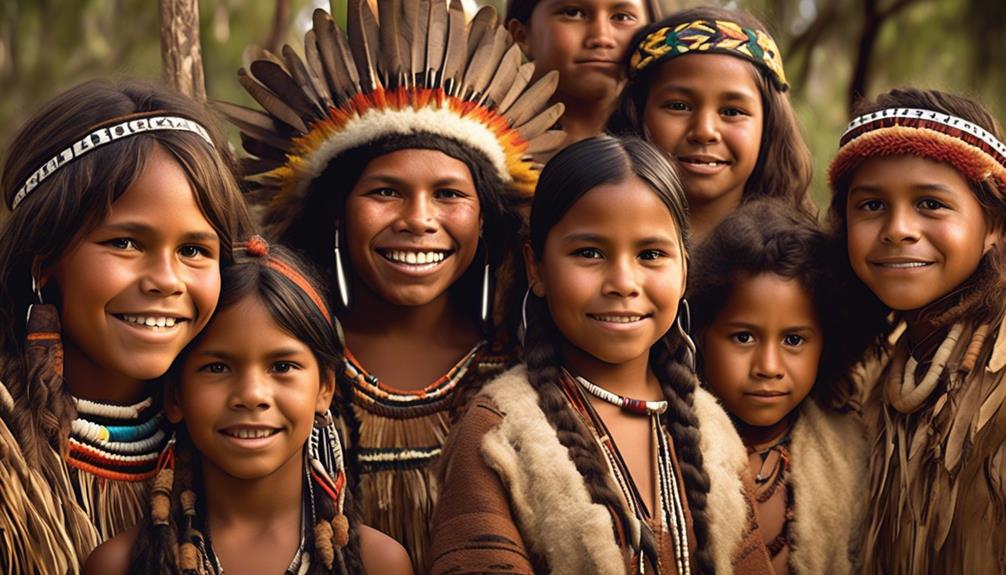
As we seek to honor and preserve Indigenous languages through culturally responsive approaches, empowering Indigenous communities to take ownership of their language revitalization efforts becomes paramount. We recognize the significance of empowering Indigenous communities in this process, and we're committed to providing the necessary support and resources to facilitate their efforts.
Empowerment not only fosters a sense of pride and ownership but also ensures the sustainability of language revitalization initiatives. To achieve this, we can:
- Share knowledge: By providing information about language revitalization strategies and resources, we can empower Indigenous communities to make informed decisions about the preservation of their languages.
- Collaborate on language programs: Working hand in hand with Indigenous communities, we can design and implement language programs that are tailored to their specific needs and cultural contexts.
- Foster leadership: Empowering individuals within Indigenous communities to take on leadership roles in language revitalization efforts can significantly contribute to the sustainability and success of these initiatives.
- Utilize existing resources: Supporting Indigenous communities in accessing and utilizing existing digitized data and technological tools can enhance the effectiveness of language revitalization efforts.
Together, by empowering Indigenous communities, we can work towards the preservation and revitalization of Indigenous languages, ensuring their cultural significance and value for generations to come.
Sustainable Language Initiatives
In our commitment to preserving Indigenous languages, we are actively developing sustainable initiatives that integrate innovative and culturally sensitive approaches. Through collaboration with Indigenous community members, including cultural and knowledge bearers, we seek to create learning opportunities that honor and revitalize traditional languages. Our sustainable language programs prioritize the inclusion of Indigenous perspectives and values, recognizing the importance of ethically engaging with Indigenous Peoples in all aspects of our work.
| Sustainable Language Initiatives | Description |
|---|---|
| Collaborative Research | Ethical collaboration with Indigenous communities for |
| the co-design of language programs and resources. | |
| Design-Based Evaluation | Iterative design and evaluation based on the needs and |
| feedback of Indigenous learners for continuous improvement. | |
| Community Language Workshops | Providing accessible and culturally relevant language |
| learning opportunities within the community. | |
| Technology Integration | Incorporating digital tools to support language |
| preservation and learning, respecting traditional knowledge. |
Frequently Asked Questions
What Is Being Done to Preserve Indigenous Languages?
We're actively engaging in language revitalization through community-driven initiatives, preserving cultural heritage and empowering Indigenous communities.
We're developing educational resources using digital technology, integrating existing digitized data to create sustainable language learning materials.
Our focus is on collaborative design-based research with Indigenous communities, ensuring practical artifacts for Indigenous language learning.
How Can We Promote Indigenous Languages?
We can promote indigenous languages through:
- Cultural revival
- Community engagement
- Language revitalization
- Education initiatives
- Advocacy efforts
By prioritizing these areas, we can empower Indigenous communities to reclaim and celebrate their linguistic heritage.
Through collaborative and culturally sensitive approaches, we can foster a renewed appreciation for Indigenous languages, ensuring their preservation for future generations.
Embracing these efforts will contribute to the overall well-being and empowerment of Indigenous communities.
Why It Has Been Difficult to Retain Aboriginal Languages in Australia?
It's been challenging to retain Aboriginal languages in Australia due to a range of factors. Challenges like limited resources, inter-generational language transmission, and the dominance of English have hindered cultural preservation and language revitalization efforts.
Community engagement and educational support are crucial. Addressing these issues can help create sustainable language programs that meet the needs of Indigenous Australian communities, fostering pride and connection to their linguistic heritage.
What Is the Framework for Aboriginal Languages?
The framework for Aboriginal languages is a pivotal tool for language revitalization and preservation. Its development integrates cultural sensitivity, community engagement, and educational resources.
Our focus is on creating future-proof language programs that honor Indigenous cultures. It emphasizes collaborative efforts with Indigenous communities to design effective computer-assisted language learning (CALL) programs.
A noteworthy statistic is 120 Indigenous languages are spoken in Australia, highlighting the need for sustainable language revitalization efforts.
Conclusion
In conclusion, it's imperative that we prioritize the preservation and revitalization of Indigenous languages through culturally sensitive and sustainable language programs.
By empowering Indigenous communities and embracing innovative approaches, we can ensure the long-term effectiveness and success of these initiatives.
Let's work together to ensure that Indigenous languages continue to flourish like a vibrant garden, deeply rooted in the cultural identity and heritage of Australia's First Nations peoples.
Mary is a passionate writer who brings creativity and a fresh perspective to our team. Her words have the power to captivate and inspire, making her an essential contributor to our content. Mary’s commitment to storytelling and dedication to promoting Indigenous culture ensures that her work touches the hearts of our readers. We’re fortunate to have her as part of our team.
Australian Indigenous languages
Indigenous Australian Rights In Education and Language
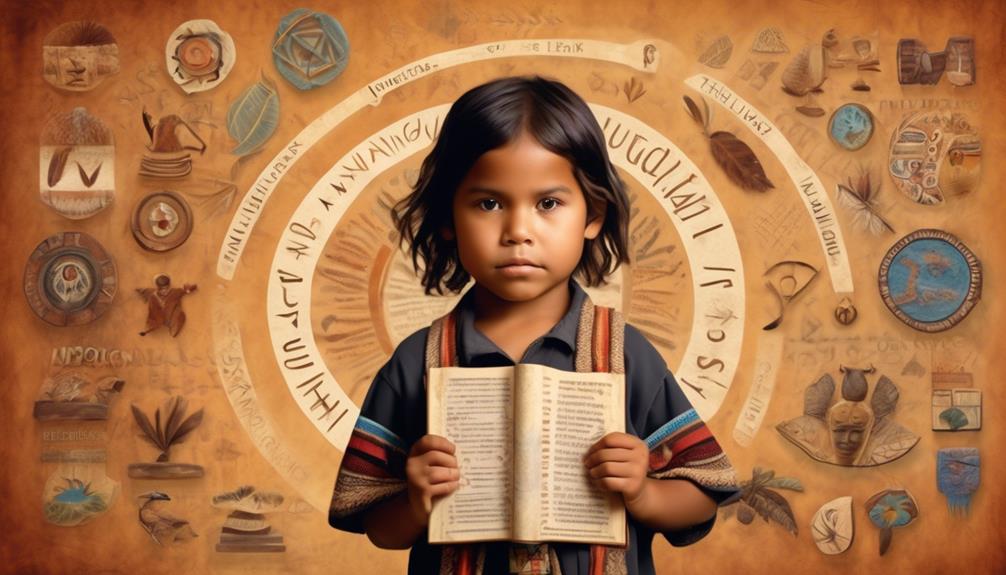
When delving into the extensive realm of education and language, it is essential to acknowledge the symbolic significance of Indigenous Australian rights within these spheres.
The intricate tapestry of Indigenous cultures and languages holds within it the essence of Australia's rich heritage, and the preservation of these invaluable aspects is paramount.
However, the journey towards equity and inclusivity for Indigenous Australians in education and language is not without its challenges. There are complexities that demand our attention and concerted efforts towards understanding and action.
Join us as we unravel the historical context, grapple with the challenges, and explore the impact of policy changes on Indigenous education, ultimately aiming to uphold Indigenous rights and create a more inclusive and diverse educational landscape.
Key Takeaways
- Systemic challenges and discriminatory practices in Indigenous education
- Neglect of cultural methods of teaching and language preservation
- Shift towards a human rights-based approach in Indigenous education policy
- Preservation and revitalization of Indigenous languages and cultures
Historical Context of Indigenous Education
Examining the historical context of Indigenous education reveals the systemic challenges and discriminatory practices that have shaped the experiences of First Nations, Aboriginal, and Torres Strait Islander students in Australia. The government's historical classification of Aboriginal people based on their ancestry during the protection era has had a lasting impact on Indigenous education. This discriminatory practice has perpetuated a deficit and failure-focused discourse in Aboriginal education policy literature, undermining the potential of Indigenous students.
Furthermore, the One Literacy movement in Australian schooling has contravened the human rights of Aboriginal students by neglecting cultural methods of teaching and language preservation. However, it's crucial to recognize that the Australian Government now acknowledges the significance of Indigenous Peoples' cultural methods of teaching and is working towards integrating them into the education system.
Challenges in Preserving Native Languages
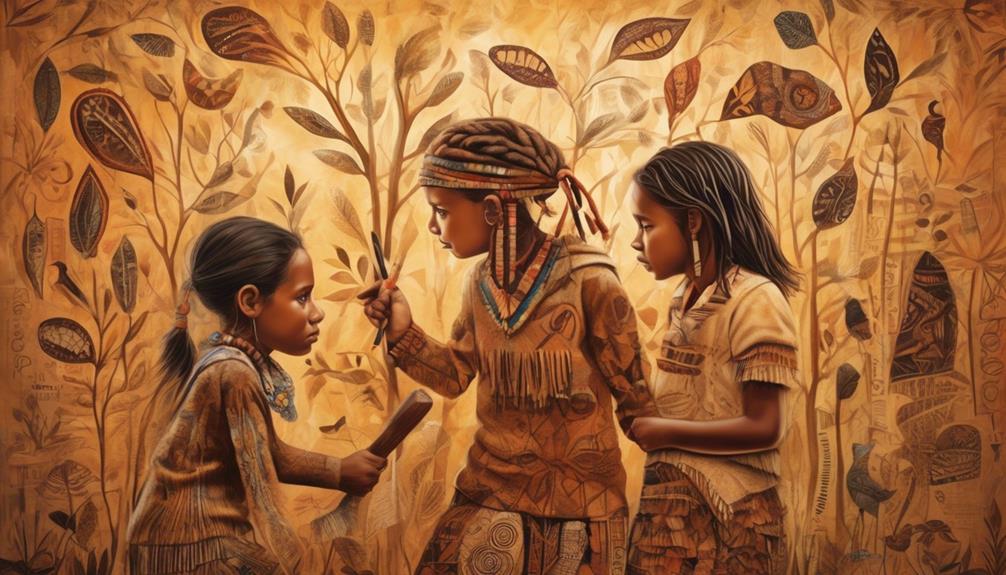
Preserving native languages among Indigenous Australian communities faces significant challenges due to historical classifications and policies that have neglected their linguistic needs and milestones. The teaching of First Nations Languages encounters hurdles due to the prioritization of Standard Australian English literacy, which disregards the linguistic requirements of Aboriginal-language-speaking students.
The Department of Education's focus on economic success through the One Literacy movement poses a significant challenge to supporting the learning of First Nations languages. Furthermore, the implementation of non-Aboriginal benchmarks for educational success contributes to a deficit discourse that overlooks the unique language and literacy milestones of Aboriginal students.
Over time, government policies have oscillated from restricting education during the protection era to recognizing and supporting Aboriginal languages in the era of multiculturalism, affecting the preservation of native languages.
To address these challenges, it's crucial to emphasize the importance of supporting First Nations Educators and the learning of Indigenous people. Collaborative efforts with schools and initiatives such as the Indigenous Languages and Learning Program are vital for the revitalization of Indigenous languages and supporting language learners.
Impact of Policy Changes on Indigenous Education
Policy changes have significantly influenced the classifications and descriptions of Aboriginal students, shaping their treatment and educational opportunities. These changes have been driven by a growing recognition of the importance of First Nations' rights in educational systems and institutions.
As a result, the Government has committed to addressing discriminatory policies and promoting equity for Aboriginal and Torres Strait Islander students. The impact of these policy changes on Indigenous education is evident in several key areas:
- Equity in Education: The Government recognizes the historical disparities faced by Indigenous students and has implemented measures to address these issues. This includes targeted support for Aboriginal and Torres Strait Islander students in primary schools to ensure they have equal access to quality education.
- Human Rights Perspective: Policy changes are aligned with the United Nations Declaration on the Rights of Indigenous Peoples, emphasizing the need to uphold the rights of First Nations peoples within the education system. This has led to a shift towards a human rights-based approach in Indigenous education policy.
- Cultural Inclusivity: The evolving policies aim to create culturally inclusive educational environments that respect and celebrate the diversity of Indigenous cultures. This involves incorporating Indigenous perspectives and languages into educational curricula to provide a more holistic and empowering learning experience for Aboriginal and Torres Strait Islander students.
The Role of Bilingualism in Indigenous Education
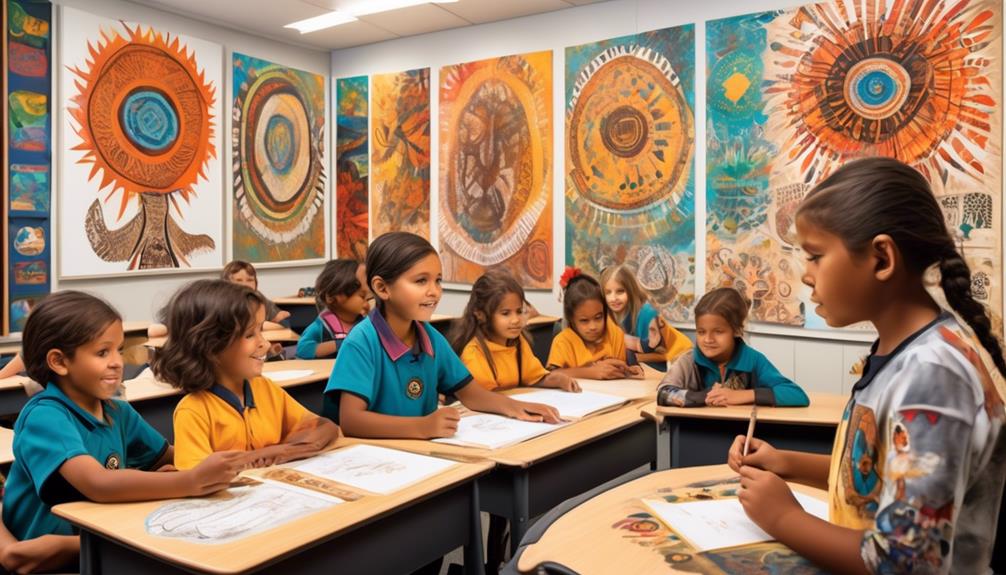
The incorporation of bilingualism in Indigenous education plays a pivotal role in preserving and revitalizing Indigenous languages and cultures. Bilingual education enables Indigenous students to learn in their First Language and Culture, fostering a sense of belonging, self-confidence, and academic achievement.
It also serves as a bridge, facilitating communication and connection between Indigenous and non-Indigenous Australian communities. Government support and funding for bilingual education initiatives are crucial for the sustainability and long-term impact of Indigenous language education.
Additionally, advocating for the establishment of a First Nations-led education system in Australia is imperative to ensure that Indigenous children have access to education in their First Language and Culture. This aligns with the cultural rights of Indigenous Australians, including those from the Torres Strait, and is instrumental in addressing historical injustices in education.
Embracing bilingualism in Indigenous education isn't only a means of promoting linguistic diversity but also a step towards reconciliation and empowerment for Indigenous communities across Australia.
Strategies for Upholding Indigenous Rights
Advocating for Indigenous rights in education requires a comprehensive approach that challenges existing governmental techniques and promotes the recognition of First Nations languages and cultures. To uphold these rights effectively, we must focus on the following strategies:
- Empower Indigenous communities to establish and control their educational systems, ensuring that the curriculum reflects and respects their languages and cultures. This approach will provide a more inclusive and culturally relevant education for Indigenous students, empowering them to succeed while preserving their heritage.
- Support institutions providing education in the Torres Strait and other Indigenous communities, fostering an environment that values and incorporates First Nations language learning and teaching. By doing so, we can promote linguistic diversity and elevate the status of Indigenous languages within the broader educational landscape.
- Advocate for a shift in the mainstream education system in Australia, challenging the current assessment methods that perpetuate a deficit-focused discourse. By pushing for a more holistic and culturally sensitive approach to evaluating educational success, we can better honor the Rights of Indigenous students and communities.
Frequently Asked Questions
Do Australian Schools Teach Aboriginal Language?
Yes, Australian schools teach Aboriginal languages as part of a cultural preservation initiative.
This involves curriculum inclusion, community engagement, and addressing language barriers.
The program aims to revitalize linguistic diversity, promote Indigenous knowledge, and foster cultural identity.
It's vital for reconciliation efforts and supports Indigenous rights in education.
We're committed to providing educational resources and collaborating with First Nations communities to ensure authentic language teaching and ownership.
When Did Indigenous Get the Right to Education in Australia?
We gained Indigenous rights to education in Australia in 1962, marking a pivotal moment in our educational timeline. This shift allowed for more inclusive and standardized efforts in providing education for Indigenous Australians. It was a crucial step towards recognizing disparities and injustices in Indigenous education.
Yet ongoing advocacy and policy development are essential to ensure equitable and culturally appropriate education. This includes focusing on cultural preservation, language revival, government policies, community empowerment, and curriculum development for educational equity. These efforts are necessary to address the unique educational needs and challenges faced by Indigenous communities and to ensure that their cultural heritage is respected and integrated into the education system.
What Role Do Languages Play in the Declaration on the Rights of Indigenous Peoples?
Languages play a pivotal role in the UN Declaration on the Rights of Indigenous Peoples. They advocate for language preservation, cultural identity, and educational empowerment. The significance of languages lies in safeguarding traditional knowledge and mitigating colonial impact. They are integral to Indigenous representation, linguistic diversity, and global recognition of human rights.
It is a testament to the universal value of linguistic diversity and the imperative of respecting Indigenous languages worldwide to uphold the rights and dignity of Indigenous communities.
What Are the Barriers to Aboriginal Education in Australia?
We face numerous barriers to Aboriginal education in Australia. Discrimination, limited educational resources, and socioeconomic factors hinder our progress.
Teacher training, language preservation, and access to traditional knowledge are vital. Additionally, the colonial history impacts us greatly. The remote communities face unique challenges and struggle to maintain their cultural identity.
Overcoming these hurdles requires a comprehensive approach that addresses the multifaceted issues within the education system.
Conclusion
In conclusion, it's high time we put our money where our mouth is and truly support Indigenous rights in education and language.
It's not enough to just talk the talk – we need to walk the walk and ensure that Indigenous cultures and languages are preserved and celebrated in our schools.
Let's make sure that Indigenous Australians have the tools and resources they need to thrive and pass on their rich heritage for generations to come.
Mary is a passionate writer who brings creativity and a fresh perspective to our team. Her words have the power to captivate and inspire, making her an essential contributor to our content. Mary’s commitment to storytelling and dedication to promoting Indigenous culture ensures that her work touches the hearts of our readers. We’re fortunate to have her as part of our team.
Torres Strait Islander Languages
Preserving Torres Strait Islander Languages
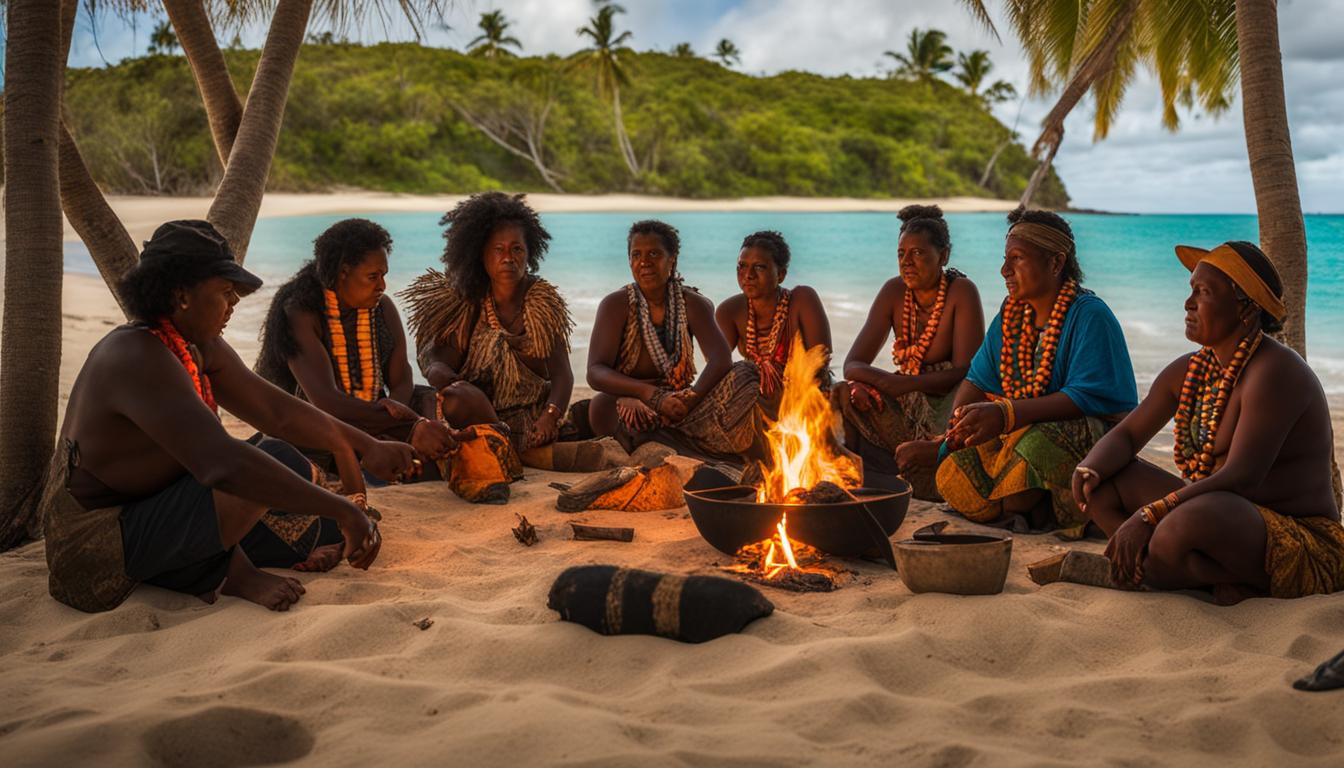
Every July, we come together to celebrate NAIDOC Week, a time set aside to honor and raise awareness about the circumstances and stories of Indigenous Australians. A key focus of this celebration is highlighting the importance and richness of Torres Strait Islander languages. These languages are not just for communication; they hold a wealth of knowledge about law, geography, history, culture, and more.
Over time, the number of Indigenous language groups in the Torres Strait has dwindled. Of the 250 distinct languages once spoken, only around 120 survive today. It is crucial for us to raise awareness and support programs that revitalize and preserve these languages, ensuring their survival for future generations.
Key Takeaways
- Torres Strait Islander languages hold immense cultural and historical significance.
- Out of the 250 Indigenous language groups, only around 120 are still spoken today.
- Preserving and revitalizing these languages is essential for safeguarding Indigenous cultural heritage.
- Efforts are underway to support language revitalization programs and integrate Indigenous languages in education.
- Collaborative partnerships with Indigenous communities are crucial in developing effective language preservation strategies.
Importance of Indigenous Languages
Indigenous languages are the breath of life for Aboriginal and Torres Strait Islander peoples. They hold immense cultural significance and convey knowledge about various aspects of life, deeply rooted in the land and spirituality. Each traditional language is intricately connected to a specific area, carrying the wisdom, customs, and beliefs of generations past. For Indigenous nations, speaking and preserving their ancestral languages is not just a means of communication but a way to maintain a profound connection with their ancestors, land, and law. Therefore, it is crucial to raise awareness about the cultural significance of Torres Strait Islander languages and the urgent need for language preservation in the Torres Strait.
To truly understand the value of Indigenous languages, we must recognize their integral role in expressing and preserving cultural heritage. These languages hold within them the essence of Indigenous identity, encompassing stories, songlines, spiritual teachings, and traditional knowledge passed down through generations. By speaking their heritage languages, Indigenous communities embody and celebrate their unique cultural identity, fostering a sense of belonging and strengthening their ties with the past. Furthermore, Indigenous languages offer profound insights into diverse ecosystems, traditional practices, and sustainable land management, demonstrating the intricate relationship between people and their environment.
“Language is the carrier of our stories. It connects us with our ancestors, our families, and our communities. It holds our cultural values, laws, and customs. Without language, we lose part of who we are.”
By preserving and revitalizing Indigenous languages, we not only safeguard cultural heritage but also create spaces for intergenerational wisdom to thrive. Each language embodies a unique worldview, an invaluable perspective that enriches our collective understanding of the world. Moreover, language preservation strengthens social connections within Indigenous communities, enabling the transmission of cultural knowledge, facilitating stronger social ties, and fostering community cohesion. Through language, Torres Strait Islander peoples honor their ancestors, strengthen their cultural resilience, and ensure the flourishing of diverse Indigenous cultures for generations to come.
The Cultural Significance of Torres Strait Islander Languages
Language Revitalization Efforts
Recognizing the pressing need to preserve Indigenous languages, the Australian government invests over A$20 million annually in activities that assist Aboriginal and Torres Strait Islander people in expressing, preserving, maintaining, and celebrating their cultures through languages and arts. This funding supports community-based Indigenous Language Centres working on 165 languages and diverse traditional and contemporary Indigenous arts projects. Additionally, the government has committed A$10 million over four years to protect, preserve, and celebrate Indigenous languages. Innovative digital solutions, digital skills programs, and career pathways for language workers and linguists are being developed to capture, teach, and revitalize Aboriginal and Torres Strait Islander languages.
Efforts to preserve and revitalize Indigenous languages in the Torres Strait and across Australia are backed by substantial government funding. These initiatives are essential in safeguarding linguistic diversity and ensuring the preservation of the linguistic heritage of Torres Strait Islander communities. The investment of over A$20 million annually supports community-based Indigenous Language Centres that work tirelessly to document, preserve, and maintain Indigenous languages.
The funding also enables the development of diverse traditional and contemporary Indigenous arts projects, promoting cultural expression through various artistic forms. Moreover, the commitment of A$10 million over four years emphasizes the government’s dedication to protect, preserve, and celebrate Indigenous languages. The development of innovative digital solutions, digital skills programs, and career pathways for language workers and linguists further strengthens the efforts to revitalize Aboriginal and Torres Strait Islander languages.
This comprehensive approach highlights the government’s commitment to supporting the linguistic and cultural heritage of Torres Strait Islander communities, ensuring that these invaluable languages are not lost but instead flourish for future generations.
Collaboration and Partnerships
The preservation and revitalization of Indigenous languages in Australia are collaborative efforts between the Australian government and Indigenous communities. Recognizing the significance of Indigenous languages, a National Indigenous Languages Convention was held in 2018. This convention brought together delegates from Indigenous Language Centres, governments, industry, education, and the community.
“Indigenous languages are a vital part of Australia’s cultural heritage and identity. Collaboration is essential to ensure their preservation and future.”
Through collaboration, the convention served as a platform to articulate the current status of Indigenous languages in Australia and explore opportunities for their revitalization. Furthermore, partnerships with esteemed organizations like the Australian Institute of Aboriginal and Torres Strait Islander Studies and the Australian National University are being forged. These partnerships aim to develop comprehensive reports on Indigenous languages, bringing insightful research and expertise to the field.
Collaborative Efforts for Indigenous Languages
Collaboration between the Australian government and Indigenous communities is essential in implementing effective language preservation policies and ensuring the cultural sustainability of Aboriginal and Torres Strait Islander languages. By fostering partnerships, we can collectively work towards preserving the linguistic diversity and cultural heritage of Australia’s Indigenous peoples.
| Partnerships | Organizations |
|---|---|
| Australian Institute of Aboriginal and Torres Strait Islander Studies | Research, documentation, and preservation of Indigenous languages |
| Australian National University | Conducting comprehensive studies and reports on Indigenous languages |
| Indigenous Language Centres | Community-based organizations working on Indigenous language preservation |
Through these collaborations, we can leverage resources, expertise, and community knowledge to develop effective strategies and initiatives for the preservation and revitalization of Indigenous languages.
Integration of Indigenous Languages in Education
Universities and educational institutes play a crucial role in the preservation and revitalization of Indigenous languages. At La Trobe University, we actively incorporate Indigenous languages and culture into our organizational structure, recognizing their significance in preserving Australia’s linguistic heritage. Our Indigenous Education Strategy embraces dreaming, cultural integrity, Indigenous knowledge, and more to create an inclusive and culturally diverse learning environment.
Teaching children in their first language, particularly in the early years, has been proven to enhance educational outcomes. By integrating Indigenous languages into education, we can not only help keep these traditional languages alive but also foster mutual understanding and bridge the gap between Indigenous and non-Indigenous communities.
The Power of Language in Education
Incorporating Indigenous languages in the curriculum offers numerous benefits:
- Preservation: By teaching Indigenous languages, we actively participate in language preservation efforts, ensuring the continuous transmission of cultural knowledge and heritage.
- Cultural Connection: Language is an essential component of cultural identity. Integrating Indigenous languages helps students develop a greater appreciation for diverse cultures and promotes a sense of belonging.
- Inclusive Learning: Inclusion is at the core of incorporating Indigenous languages in education. Acknowledging and valuing the linguistic diversity of Australia fosters a sense of respect and empathy among students.
- Improved Academic Outcomes: Studies have shown that teaching children in their first language enhances their cognitive development, linguistic abilities, and overall educational outcomes.
“Language is more than just words; it carries our culture, our traditions, our understanding of the world.” – Dr. Amanda Rasmussen, Linguistics Professor at La Trobe University
By integrating Indigenous languages in education, we create an environment that not only preserves language but also nurtures cultural pride and understanding. Through our commitment to linguistic diversity, La Trobe University is dedicated to fostering the revitalization and preservation of Indigenous languages for future generations.
| Benefits of Integrating Indigenous Languages in Education | Illustration | References |
|---|---|---|
| Preservation of Indigenous languages | 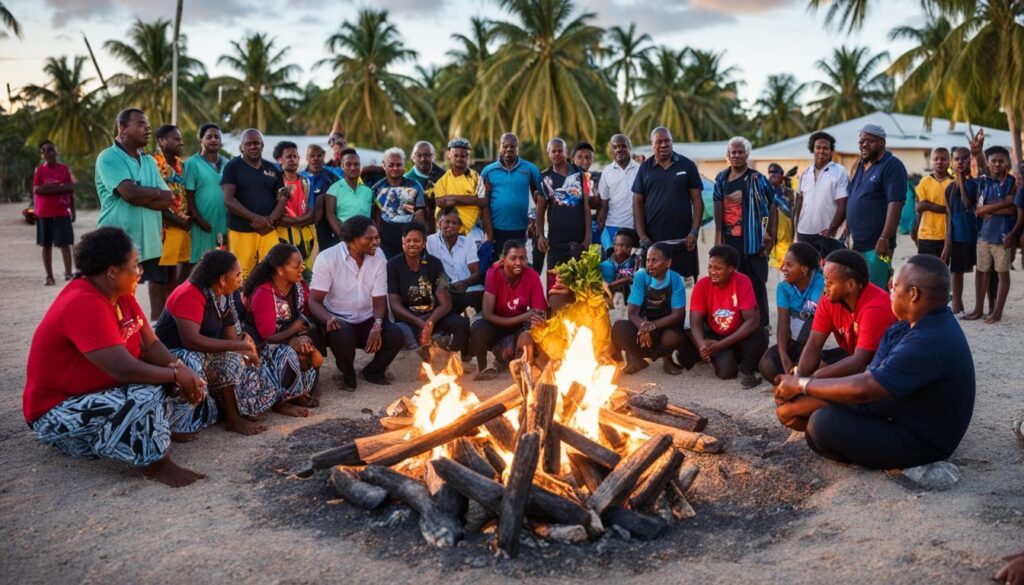 |
1 |
| Development of cultural connection | 2 | |
| Promotion of inclusive learning environments | 3 | |
| Enhanced academic outcomes | 4 |
Language Diversity in Australia
Australia is a linguistically diverse country with a rich tapestry of Indigenous languages. With over 250 distinct Indigenous languages and approximately 800 dialects, the linguistic landscape is incredibly diverse and reflects the unique cultural heritage of the Aboriginal and Torres Strait Islander peoples. Each language is intricately connected to a specific place and community, carrying with it a wealth of cultural knowledge and stories.
In different regions of Australia, the linguistic diversity varies, showcasing the rich tapestry of Indigenous languages. For example, in Arnhem Land, multiple languages are spoken in close proximity, reflecting the close connection between language and local identity. On the other hand, in regions like the Western Desert, dialects of a single language are spoken, highlighting the linguistic intricacies and variations within a language group.
Within the Torres Strait, an archipelago located between Australia and Papua New Guinea, three main languages are spoken: Kala Lagaw Ya, Meriam Mir, and Yumplatok (also known as Torres Strait Creole). These languages are central to the cultural identity of the Torres Strait Islander communities, carrying their unique stories, traditions, and knowledge.
| Region | Linguistic Diversity |
|---|---|
| Arnhem Land | Multiple languages spoken in close proximity |
| Western Desert | Dialects within a single language |
| Torres Strait | Kala Lagaw Ya, Meriam Mir, Yumplatok |
Efforts are being made to preserve and revitalize these Indigenous languages, recognizing their importance in maintaining cultural heritage and fostering a sense of belonging among Indigenous communities. Of particular focus is the Meriam Mir language, which had just over 200 speakers in 2006. By supporting language preservation initiatives and celebrating linguistic diversity, we can ensure the continuation of this invaluable cultural heritage for future generations.
Quote:
“Language is the heart of culture; it embodies our history, traditions, and connections to the land. Preserving our Indigenous languages is crucial for our cultural survival and the well-being of our communities.” – Torres Strait Islander Elder
Language is Identity
Language is more than just a means of communication; it is an integral part of our cultural identity. Indigenous languages in the Torres Strait are deeply intertwined with songlines, stories, spirituality, law, and customs. They carry the important knowledge passed down from our ancestors and elders. Speaking and learning our first languages provide us with a sense of belonging and empowerment.
Preserving and revitalizing Indigenous languages is crucial for maintaining our cultural heritage and ensuring that future generations have a strong connection to their identity.
Our Indigenous cultural heritage is deeply embedded in our languages, which hold significant value and meaning. By preserving and revitalizing our languages, we preserve and revitalize our cultural identity and pass on the knowledge, traditions, and wisdom of our ancestors.

Challenges and Revival Efforts
Past government policies have deeply impacted the preservation and transmission of Indigenous languages in Australia. Forced relocations of Indigenous communities and the separation of children from their families resulted in the suppression of many Indigenous languages and the severing of intergenerational links. Consequently, future generations have been left with limited knowledge of their ancestral languages.
However, languages are resilient and never truly lost. Efforts are now underway to recover and revitalize Indigenous languages, ensuring their preservation for future generations. Collaboration with Elders, historical records, and language centers plays a key role in this revitalization process.
“Languages are not just means of communication; they carry knowledge about law, geography, history, and culture.”
– Torres Strait Islander Elder
By working closely with Indigenous Elders, their invaluable knowledge and understanding of Indigenous languages are being harnessed. Elders are sharing their language skills, cultural insights, and oral traditions with younger generations, helping to bridge the gap and revitalize Indigenous languages.
Historical records, such as audio recordings, written documentation, and language dictionaries, are invaluable resources for language revival efforts. These records provide a foundation for language reclamation and give insights into pronunciation, grammar, and vocabulary.
Furthermore, language centers play a crucial role in the revitalization of Indigenous languages. These centers serve as hubs for language documentation, resource development, and language learning programs.
Ultimately, the revival of Indigenous languages is a collaborative effort that involves Indigenous communities, government support, and wider recognition of the cultural and linguistic heritage that these languages represent.
Challenges and Revival Efforts
| Challenges | Revival Efforts |
|---|---|
| Forced relocations and family separations | Collaboration with Elders to share language skills and cultural knowledge |
| Suppression of Indigenous languages | Utilization of historical records for language reclamation |
| Limited intergenerational transmission | Establishment of language centers for language documentation, resource development, and language learning programs |
Acknowledging Language Diversity
Acknowledging and valuing the diversity of Indigenous languages is essential. On the Torres Strait Islands alone, three main languages are spoken: Kala Lagaw Ya, Meriam Mir, and Yumplatok (Torres Strait Creole). Each language is specific to different islands and communities, reflecting the unique cultural heritage of the region. By celebrating and preserving these diverse languages, we can foster a greater appreciation for linguistic and cultural diversity among all Australians.
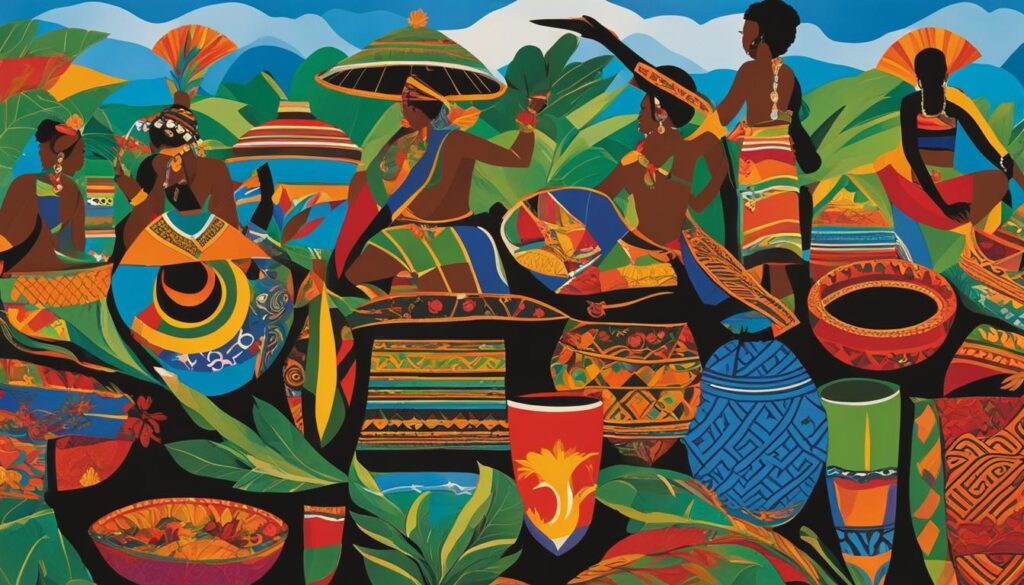
| Language | Main Islands/Communities |
|---|---|
| Kala Lagaw Ya | Mainland (Cape York), Mabuiag Island, Badu Island |
| Meriam Mir | Mer Island |
| Yumplatok (Torres Strait Creole) | Across multiple islands in the Torres Strait |
Language Centers for Language Preservation
Language centers play a vital role in the preservation and promotion of Indigenous languages. In Australia, we are fortunate to have twenty-two Indigenous Language Centers dedicated to maintaining, preserving, and promoting the diversity of Indigenous languages. These centers serve as essential hubs for language documentation, revitalization, and the development of valuable resources like dictionaries.
Through their dedicated efforts, these language centers contribute significantly to the preservation of Indigenous languages and cultural heritage. They work closely with Indigenous communities, Elders, linguists, and scholars to ensure the accurate documentation and revival of languages that might otherwise be lost.
Language centers are at the forefront of language revitalization programs, utilizing various methods such as immersive language programs, community workshops, and digital resources to promote language learning and engagement. These programs create opportunities for Indigenous communities to reconnect with their linguistic heritage and pass on invaluable cultural knowledge to future generations.
Indigenous languages are not just a means of communication; they hold the wisdom, stories, and connection to our identity as Aboriginal and Torres Strait Islander peoples. Language centers play a vital role in ensuring that our languages continue to thrive and enrich our communities.
Language Documentation and Preservation
Language centers actively engage in comprehensive language documentation and preservation efforts, capturing linguistic data, vocabularies, grammar rules, and oral traditions. These valuable resources serve as references for language learners, researchers, and community members who seek to understand and communicate in Indigenous languages.
Revitalization Initiatives
Language centers advocate for language revitalization on multiple fronts. They organize language immersion programs, language workshops, and cultural events that celebrate Indigenous languages. These initiatives create spaces where language learners can practice speaking, listening, and writing in their ancestral languages, fostering a sense of pride and connection to their cultural heritage.
Development of Language Resources
Language centers play a vital role in developing language resources, including dictionaries, textbooks, and digital learning materials. These resources serve as essential tools for language learners, teachers, and the broader community interested in exploring and embracing Indigenous languages.
| Key Roles of Language Centers | Examples |
|---|---|
| Language Documentation | Compilation of vocabulary, grammar rules, and oral traditions |
| Language Revitalization Programs | Language immersion programs, workshops, and cultural events |
| Development of Language Resources | Creation of dictionaries, textbooks, and digital learning materials |
By supporting these language centers, we contribute to the preservation of Indigenous languages and the revitalization of cultural heritage. Together, we can ensure that Indigenous languages continue to flourish, enriching our communities with vibrant expressions of identity, knowledge, and connection.
Government Funding for Language Preservation
The Australian Government recognizes the cultural significance of Torres Strait Islander languages and is committed to their preservation. Through the Indigenous Languages and Arts grant program, we invest over A$20 million annually to support Aboriginal and Torres Strait Islander people in expressing, preserving, maintaining, and celebrating their cultures through languages and arts.
This funding plays a crucial role in supporting community-based Indigenous Language Centers and diverse traditional and contemporary Indigenous arts projects. By providing financial support, we aim to empower these centers to continue their important work in language revitalization and preservation.
In addition to the annual grant program, we have allocated A$10 million over four years to develop innovative digital solutions, digital skills programs, and career pathways for language workers and linguists. This investment aims to leverage technology to capture and transmit valuable cultural information while equipping language workers with the necessary skills for documentation and preservation.
The preservation of Torres Strait Islander languages is a collective effort, and the Australian Government is dedicated to working alongside Indigenous communities in this endeavor. By providing substantial funding and resources, we are committed to ensuring that future generations can connect with their cultural heritage through the languages spoken by their ancestors.
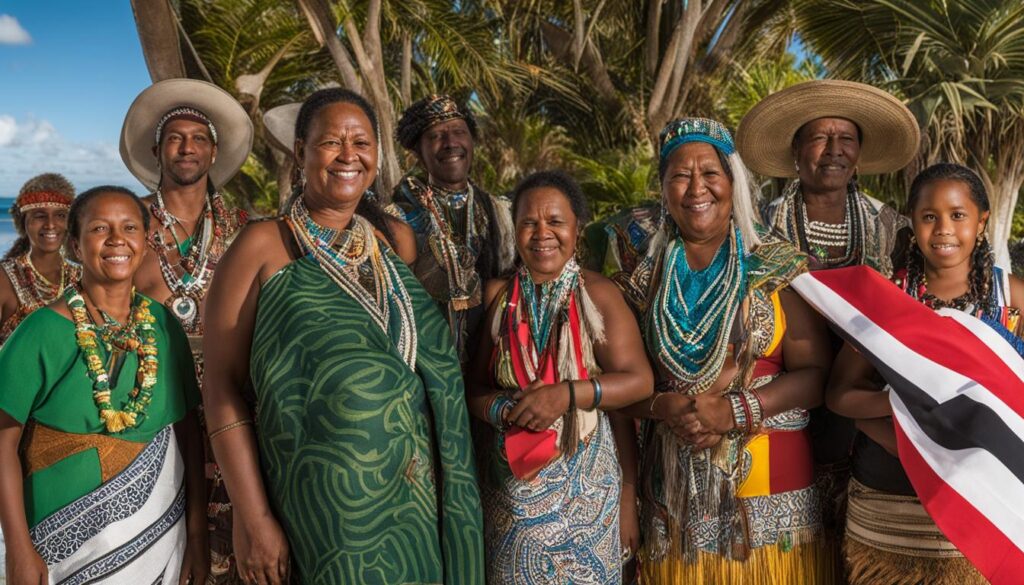
The Importance of Government Funding
The funding provided by the Australian Government serves as a lifeline for the preservation of Torres Strait Islander languages. It enables Indigenous Language Centers to operate and carry out vital language revitalization efforts, ensuring that these languages continue to be spoken and passed down to future generations.
Supporting Indigenous Language Centers
The funding supports community-based Indigenous Language Centers, which function as key hubs for language documentation, preservation, and education. These centers play a crucial role in revitalizing and maintaining Torres Strait Islander languages, working closely with communities and Elders to ensure the cultural integrity of language revival initiatives.
Empowering Language Workers
Through the allocated A$10 million, the Australian Government is investing in the development of innovative digital solutions, digital skills programs, and career pathways for language workers and linguists. This initiative aims to equip language workers with the necessary tools and knowledge to document, preserve, and revitalize Indigenous languages.
Collaboration with Indigenous Communities
We recognize that language preservation is a collaborative effort, and we are committed to ongoing engagement and collaboration with Indigenous communities. By working together, we can ensure that language revitalization initiatives are aligned with the needs and aspirations of the Torres Strait Islander community.
Investing in Cultural Heritage
The Government’s investment in language preservation is an investment in the cultural heritage of Torres Strait Islander communities. By preserving and revitalizing Indigenous languages, we are safeguarding an invaluable and irreplaceable part of Australia’s diverse cultural tapestry.
Collaborative Efforts with Indigenous Communities
The preservation and revitalization of Aboriginal and Torres Strait Islander languages require collaborative efforts and ongoing discussions with Indigenous communities. We recognize the importance of engaging with various stakeholders to develop and implement effective Indigenous languages policies. One such collaborative effort is the National Indigenous Languages Convention, which serves as a platform for Indigenous Language Centers, government bodies, industry representatives, educational institutions, and the community to come together.
Through the National Indigenous Languages Convention, we facilitate open dialogues and information sharing to ensure that the preservation and revitalization of Indigenous languages are guided by the needs and aspirations of the Indigenous community. This collaborative approach allows us to co-create solutions that address the unique challenges and opportunities in preserving and promoting Aboriginal and Torres Strait Islander languages.
Key Collaborative Initiatives:
- Bringing together Indigenous Language Centers, government bodies, industry representatives, educational institutions, and the community
- Facilitating open dialogues and information sharing through the National Indigenous Languages Convention
- Co-creating solutions to address the challenges and opportunities in language preservation and revitalization
By actively engaging with Indigenous communities, we ensure that our policies and programs are inclusive, respectful, and aligned with the aspirations of the people whose languages and cultures we aim to preserve. Collaboration is at the heart of our efforts to create a sustainable and effective framework for the revitalization of Aboriginal and Torres Strait Islander languages.
“Language is not just a means of communication, it is a way of seeing, understanding, and connecting to the world. Collaborating with Indigenous communities ensures that the revitalization of their languages is rooted in the rich cultural heritage and aspirations of the people themselves.”
The power of collaboration is evident in the progress we have made so far in preserving and revitalizing Indigenous languages. By continuing to work together, we can safeguard this valuable heritage for future generations and foster a culturally diverse and inclusive Australia.
Indigenous Language Revitalization Programs
Language revitalization programs play a crucial role in the preservation and promotion of Indigenous languages. These initiatives focus on reclaiming and revitalizing languages that have been endangered or lost due to historical factors. By collaborating with Elders, conducting archival research, and engaging with the community, these programs aim to revive languages and ensure their transmission to future generations.
Through these language revitalization efforts, we can contribute to the preservation of Indigenous cultural heritage and the revitalization of languages in the Torres Strait and across Australia.
“Language is more than just words; it holds the essence of our cultural identity and connects us to our ancestors.”
These programs involve various strategies to revive Indigenous languages, such as:
- Developing language immersion programs
- Creating language learning resources
- Organizing cultural events and language workshops
- Supporting language documentation and research
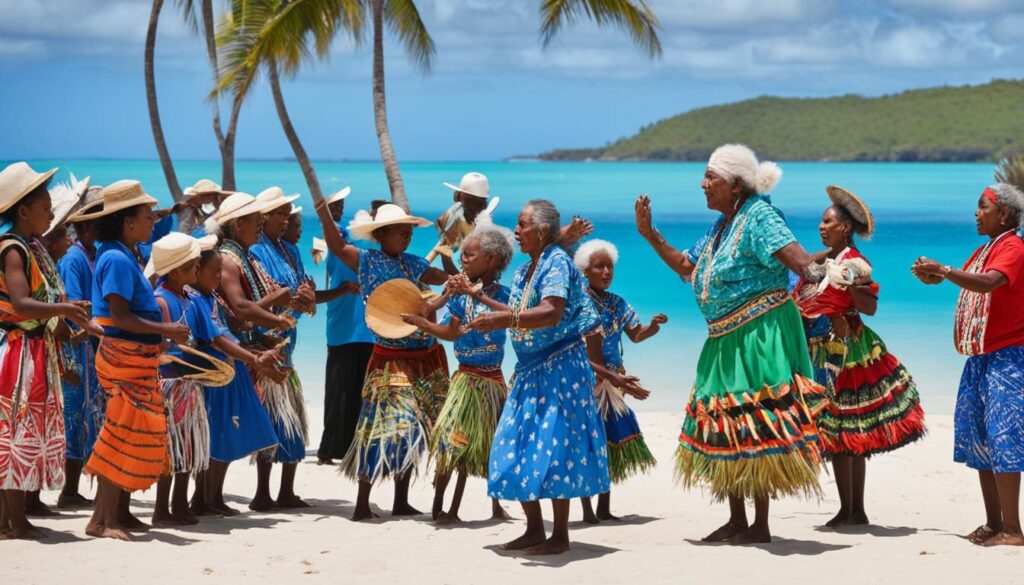
The revitalization of Indigenous languages not only preserves linguistic diversity but also strengthens the cultural fabric of Indigenous communities. It allows for the transmission of traditional knowledge, stories, and values that are integral to their cultural identity.
By supporting and participating in these language revitalization programs, we can contribute to the preservation of Indigenous cultural heritage and empower Indigenous communities to reclaim their linguistic identity. Together, we can ensure that the rich tapestry of Indigenous languages continues to thrive for generations to come.
Incorporating Indigenous Languages in Education
Education plays a crucial role in the preservation and revitalization of Indigenous languages. We believe that by teaching children in their first language, particularly during their early years, we can greatly improve their educational outcomes. It is essential to integrate Indigenous languages into schools and educational institutions to not only transmit cultural knowledge but also strengthen the connection between language and cultural identity. Through this integration, we can empower future generations to embrace their linguistic heritage and create a more inclusive and culturally diverse learning environment.
The Benefits of Indigenous Language Education
Incorporating Indigenous languages into education has numerous benefits for both Indigenous and non-Indigenous students. Here are some key advantages:
- Preserving and Revitalizing Traditional Languages: By incorporating Indigenous languages into the curriculum, we actively contribute to the preservation and revitalization of traditional languages.
- Strengthening Cultural Identity: Language is deeply intertwined with cultural identity. By learning and using Indigenous languages, students foster a stronger connection to their heritage and develop a sense of belonging.
- Improved Educational Outcomes: Studies have shown that teaching children in their first language enhances their cognitive development and academic performance. It provides a solid foundation for further learning and engagement.
- Fostering Intercultural Understanding: Incorporating Indigenous languages in education promotes intercultural understanding and respect among students from different backgrounds. It helps to break down barriers and build bridges of communication.
“Incorporating Indigenous languages in education is a powerful way to acknowledge and honor the rich linguistic and cultural diversity of our country.”
Successful Examples of Indigenous Language Integration
Many schools and educational institutions in Australia are already taking proactive steps to incorporate Indigenous languages into their curricula. Here are a few successful examples:
| School/Institution | Location | Integration Approach |
|---|---|---|
| Bawaka Cultural Experience | Yirrkala, NT | Integrates Yolngu language and culture into education through immersion programs, cultural excursions, and language classes. |
| Woorabinda State School | Woorabinda, QLD | Offers a bilingual program that provides instruction in both English and the local Wadja Wadja language. |
| Marrara Christian College | Darwin, NT | Includes an Aboriginal and Torres Strait Islander culture and language program that encompasses various aspects of Indigenous knowledge and traditions. |
These initiatives serve as inspiring models for incorporating Indigenous languages into education, fostering cultural pride, and promoting intercultural understanding among students. They demonstrate the commitment to preserving and revitalizing traditional languages while enriching the overall educational experience.
Incorporating Indigenous languages in education not only benefits Indigenous communities but also enriches the cultural fabric of our nation as a whole. It is a powerful way to acknowledge and honor the rich linguistic and cultural diversity of our country. By embracing Indigenous languages, we can create a more inclusive and culturally sensitive learning environment that celebrates and values the linguistic heritage of the Torres Strait and all traditional languages throughout Australia.
The Power of Language in Cultural Connection
Speaking in Indigenous languages is more than just a form of communication. It is a powerful way for Indigenous communities to connect with their ancestral spirits and maintain a strong cultural identity. Language holds deep meaning and serves as a platform for passing on cultural knowledge and heritage from one generation to the next.
By speaking and learning their first languages, Indigenous communities strengthen their sense of belonging and create a bridge to their cultural roots. Language is a vital part of their cultural heritage, and it plays a crucial role in preserving and transmitting indigenous traditions, stories, and spirituality.
Just as language shapes and reflects culture, cultural heritage is deeply engrained in language. Each word and phrase carries historical wisdom, traditions, and customs that have been passed down through generations. The linguistic heritage of Torres Strait Islander communities not only tells stories of the past but also holds the keys to understanding the present and shaping the future.
“Language is the road map of a culture. It tells you where its people come from and where they are going.” – Rita Mae Brown
Linguistic Heritage in Torres Strait
In the Torres Strait, preserving linguistic heritage is of utmost importance. The region is home to three main languages: Kala Lagaw Ya, Meriam Mir, and Yumplatok (Torres Strait Creole), each with its distinct dialects and cultural significance. These languages connect the Torres Strait Islander communities to their land, spiritual beliefs, and ancestral practices.
| Language | Number of Speakers | Region |
|---|---|---|
| Kala Lagaw Ya | Approximately 7,000 | Western and Central Torres Strait islands |
| Meriam Mir | Approximately 2,000 | Mer Island and Meriam community in the Eastern Islands |
| Yumplatok (Torres Strait Creole) | Approximately 25,000 | Widely spoken across the Torres Strait region |
Through dedicated language revitalization efforts, these languages are being documented, taught, and celebrated. Language centers, community initiatives, and educational programs are working together with Torres Strait Islander communities to ensure the preservation and continuity of their unique linguistic heritage.
By valuing and supporting the linguistic heritage of Torres Strait Islander communities, we honor their rich cultural legacy and contribute to a vibrant, diverse, and inclusive society.
Conclusion
Preserving Torres Strait Islander languages is vital for safeguarding Indigenous cultural heritage. These languages are not just tools for communication; they hold immense knowledge about law, history, spirituality, and the deep connection to the land. Efforts such as government funding, collaboration with Indigenous communities, and integrating Indigenous languages in education are essential in this endeavor.
By valuing, preserving, and revitalizing Indigenous languages, we can ensure that this invaluable cultural heritage is passed on to future generations. Language preservation strengthens Indigenous communities and fosters a more inclusive and culturally diverse society. It allows us to honor and respect the unique contributions of Torres Strait Islander peoples to Australia’s rich cultural tapestry.
Together, we have the power to make a difference. Let us continue supporting initiatives that promote language preservation and celebrate the Indigenous cultural heritage of the Torres Strait. By working hand in hand, we can create a future where the beauty and wisdom of these languages continue to thrive and inspire generations to come.
FAQ
Why is it important to preserve Torres Strait Islander languages?
Preserving Torres Strait Islander languages is crucial for safeguarding Indigenous cultural heritage and maintaining ancestral connections. These languages hold important knowledge about law, history, spirituality, and land connection.
How many Indigenous languages are spoken in the Torres Strait?
Three main languages are spoken in the Torres Strait: Kala Lagaw Ya, Meriam Mir, and Yumplatok (Torres Strait Creole). Each language is specific to different islands and communities.
What efforts are being made to revitalize Indigenous languages in the Torres Strait?
There are various language revitalization programs and initiatives in place, including collaboration with Elders, archival research, and community engagement. These efforts aim to reclaim and revitalize endangered or lost languages with the help of Indigenous communities and language centers.
How are Indigenous languages integrated into education?
Many educational institutions are incorporating Indigenous languages into their curriculum and organizational structure. Teaching children in their first language, especially in the early years, has been found to improve educational outcomes and strengthen cultural identity.
How linguistically diverse is Australia?
Australia is home to more than 250 Indigenous languages, including approximately 800 dialects. This linguistic diversity reflects the cultural richness and heritage of the nation.
What is the connection between language and cultural identity?
Language is an integral part of cultural identity. Indigenous languages carry cultural knowledge, stories, spirituality, and customs, connecting communities to their ancestors, land, and law. By preserving and revitalizing Indigenous languages, cultural heritage is maintained and future generations have a strong sense of identity.
What are the challenges faced in preserving and revitalizing Indigenous languages?
Historical factors such as forced relocation of Indigenous communities and the removal of children from their families have had a significant impact on the transmission of languages and cultural knowledge. However, collaborative efforts with Elders, records, and language centers are helping reclaim and revitalize endangered languages.
How can language diversity in the Torres Strait be acknowledged?
Acknowledging language diversity involves recognizing and celebrating the linguistic differences among Indigenous communities. In the Torres Strait, there are three main languages spoken: Kala Lagaw Ya, Meriam Mir, and Yumplatok (Torres Strait Creole).
What role do language centers play in preserving Indigenous languages?
Language centers are essential hubs for language documentation, revitalization, and the development of resources like dictionaries. They actively work in preserving, maintaining, and promoting the diversity of Indigenous languages.
How is the Australian government supporting language preservation?
The Australian government provides funding through the Indigenous Languages and Arts grant program to support language centers and diverse traditional and contemporary Indigenous arts projects. They are also investing in digital solutions, digital skills programs, and career pathways for language workers and linguists.
How does collaboration with Indigenous communities play a role in language preservation?
Collaboration with Indigenous communities ensures that language preservation efforts are informed by the needs and aspirations of the community. Partnerships with organizations such as the Australian Institute of Aboriginal and Torres Strait Islander Studies and the Australian National University help develop comprehensive reports on Indigenous languages.
What are Indigenous language revitalization programs?
Indigenous language revitalization programs focus on reclaiming and revitalizing endangered or lost languages. These programs involve collaboration with Elders, archival research, and community engagement to revive languages and pass them on to future generations.
How does incorporating Indigenous languages in education benefit communities?
Integrating Indigenous languages into education strengthens the transmission of cultural knowledge and fosters a greater sense of cultural identity and belonging among Indigenous communities. It also promotes mutual understanding and cultural diversity among all Australians.
How does language contribute to cultural connection?
Language is a powerful tool for connecting with ancestral spirits and maintaining a strong cultural connection. Speaking and learning first languages strengthens the sense of cultural identity and belonging within Indigenous communities, preserving Indigenous cultural heritage for future generations.
Source Links
- https://www.latrobe.edu.au/nest/naidoc-preserving-indigenous-languages/
- https://en.unesco.org/creativity/policy-monitoring-platform/protecting-preserving-celebrating
- https://aiatsis.gov.au/explore/languages-alive
Nayeli is our dedicated Editor in Chief, bringing her passion for words and keen editorial eye to every piece of content we produce. With years of experience in the field, she ensures that every article and publication meets the highest standards of quality and clarity. Nayeli’s commitment to storytelling and her deep understanding of our mission make her an invaluable leader in our team.
Australian Indigenous languages
Indigenous Languages on Radio and Online
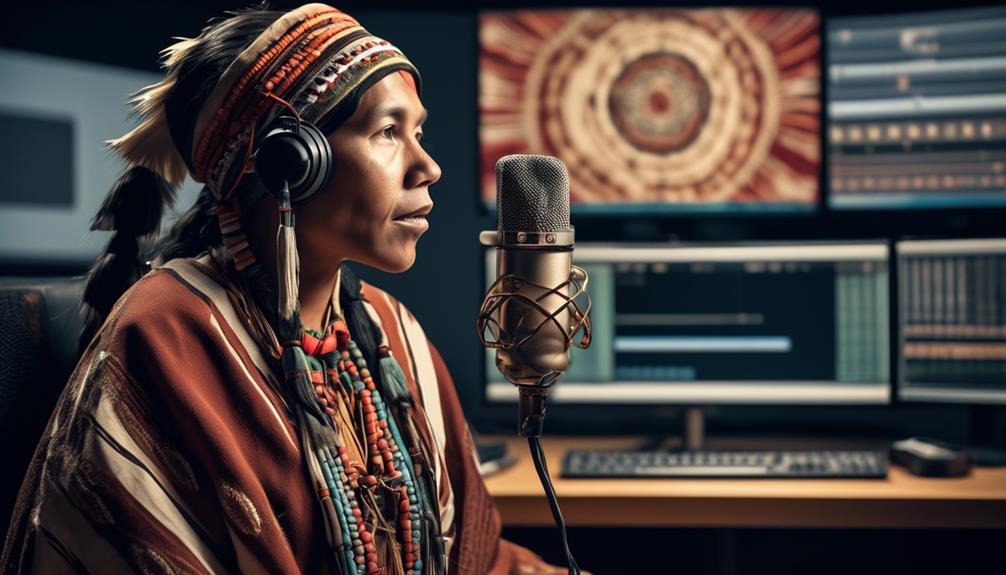
As we explore the vast world of indigenous languages through radio and the internet, it becomes apparent that these platforms play a vital role in maintaining and revitalizing linguistic diversity.
The intertwining of traditional oral storytelling with modern digital mediums has sparked a new chapter in the ongoing narrative of indigenous language preservation.
However, as we navigate through the complexities of this landscape, it's essential to uncover the opportunities and challenges that lie ahead.
Key Takeaways
- Preserving indigenous languages through radio and online platforms is crucial for maintaining cultural identity and promoting linguistic diversity within communities.
- Digital platforms provide broader access to indigenous language resources and learning materials, fostering language learning and revitalization.
- Limited allocation of time for indigenous language broadcasting hinders the preservation and promotion of indigenous languages.
- Community-run broadcasting initiatives have demonstrated the potential for supporting indigenous languages through local radio stations.
Importance of Indigenous Language Preservation
Preserving indigenous languages through radio and online platforms is crucial for maintaining cultural identity and promoting linguistic diversity within our communities. Indigenous language radio stations play a vital role in this endeavor, especially in rural areas where access to other forms of media may be limited. These community radio stations serve as a platform for the revitalization and preservation of indigenous languages, allowing Indigenous Peoples to reclaim and celebrate their local languages. By broadcasting stories, traditions, and knowledge in indigenous languages, these stations contribute to the continued existence and relevance of these languages within our communities.
However, the support for indigenous radios varies across different countries, impacting the reach and impact of these stations. National policies play a significant role in either supporting or impeding the resurgence and representation of indigenous languages in broadcasting. Challenges such as the lack of indigenous language professionals and limited airtime allocation also contribute to the struggle of indigenous language broadcasting and preservation.
Despite these challenges, the importance of preserving indigenous languages through community radio stations remains paramount for the cultural identity and linguistic diversity of our communities.
Impact of Digital Platforms on Language Revitalization
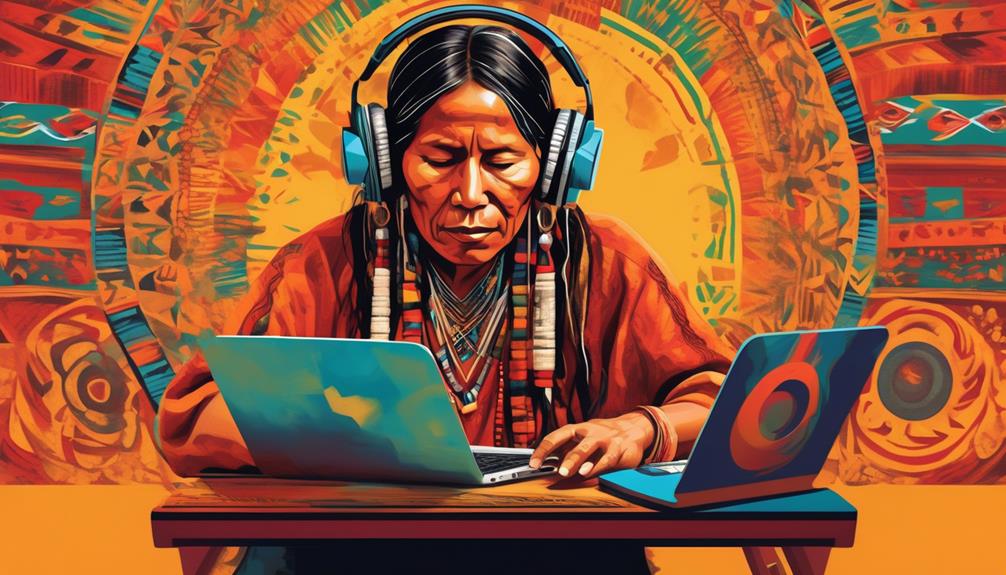
The importance of preserving indigenous languages through community radio stations extends to the impact of digital platforms on language revitalization. Digital platforms significantly influence the revitalization of indigenous languages by providing new avenues for access, preservation, and promotion. Through research and development, digital platforms are increasingly leveraging AI-driven recommendations to connect indigenous language speakers with relevant content, thus fostering language learning and revitalization. The following table highlights the key impacts of digital platforms on language revitalization:
| Impact | Description | Example |
|---|---|---|
| Access | Digital platforms provide broader access to indigenous language resources and learning materials. | Online language learning apps and courses |
| Preservation | Online platforms aid in preserving and archiving traditional indigenous language materials. | Digitized recordings, texts, and oral histories |
| Promotion and Outreach | Social media and online communities facilitate the promotion of indigenous languages. | Indigenous language content on podcasting platforms |
Challenges Faced by Indigenous Communities
Facing limited allocation of time for indigenous language broadcasting by the National Broadcasting Commission, indigenous communities encounter significant challenges in preserving and promoting their languages. The lack of indigenous language professionals and linguists in broadcast stations further exacerbates these hurdles. The high prestige of the English language as the official language overshadows indigenous languages, making it difficult for them to thrive in the electronic media landscape. Indigenous languages only occupy a small percentage of the broadcasting time, hindering their visibility and accessibility to wider audiences. Additionally, multilingual societies struggle to effectively promote and preserve their indigenous languages in the face of these challenges.
Furthermore, the difficulty in accessing relevant research and new content alerts for indigenous languages poses a significant barrier. Indigenous communities often face challenges in staying informed about new developments and resources. Additionally, schedule alerts for indigenous language programming are limited, impacting the ability to engage with and promote indigenous languages effectively.
To address these challenges, increased access to research, articles, and resources through platforms like Crossref and institutions is essential for the preservation and promotion of indigenous languages.
Opportunities in Utilizing Radio and Online Platforms

Amidst the challenges encountered by indigenous communities in preserving and promoting their languages, there are significant opportunities in utilizing radio and online platforms to empower and revitalize indigenous languages.
Community-run broadcasting initiatives have demonstrated the potential for supporting indigenous languages, such as Navajo, Nuxalk, and Poqoman Maya, through local radio stations. The cost-effectiveness of radio as a medium for indigenous language programming, including podcasts and streaming services, offers asynchronous consumption, reaching wider audiences.
National policies play a crucial role in supporting the resurgence of indigenous languages in broadcasting, highlighting the need for supportive policies.
Radio serves as a powerful tool for cultural revitalization, transmitting cultural knowledge, stories, and traditions, fostering a sense of pride and identity.
Despite the rise of new media, radio remains relevant and continues to serve as a platform for indigenous voices, stories, and conversations, indicating its crucial role in the future of indigenous languages.
Embracing these opportunities, we can conduct research, cite articles, and schedule alerts to stay updated with new research, ensuring that radio and online platforms effectively empower and revitalize indigenous languages.
Global Reach of Indigenous Language Broadcasting
Indigenous language radio stations in various countries, such as Nigeria, Colombia, Aotearoa-New Zealand, Canada, and Australia, represent community-run broadcasting initiatives. These stations serve as vital platforms for preserving and promoting indigenous languages, providing a global reach for indigenous language broadcasting. To illustrate the global reach of indigenous language radio, the table below presents a snapshot of indigenous language radio stations in different countries.
| Country | Indigenous Language Radio Stations |
|---|---|
| Nigeria | Indigenous Radio Alert, Indigenous Radio Schedule |
| Colombia | Indigenous Radio Research, Indigenous Radio Alerts |
| Aotearoa-New Zealand | Indigenous Radio Schedule, Indigenous Radio Alerts |
| Canada | Indigenous Radio Article, Indigenous Radio Research |
| Australia | Indigenous Radio Crossref, Indigenous Radio Citations |
These stations play a crucial role in connecting indigenous communities globally, offering a platform for cultural revitalization and linguistic resurgence. Additionally, radio's cost-effectiveness and engaging nature make it an effective medium for reaching a global audience. As a result, indigenous language radio contributes significantly to the preservation and revitalization of indigenous cultures and languages on a global scale.
Frequently Asked Questions
What Are the 7 Indigenous Languages?
Preserving indigenous languages is crucial for cultural identity and revitalization efforts. Colonialism has had a significant impact, leading to challenges in teaching and preserving these languages.
Immersion programs and storytelling play a vital role, as do traditional ceremonies and contemporary music. Technology has also impacted language preservation.
What Are 3 Indigenous Languages?
We can highlight three diverse Indigenous languages that are crucial in preservation efforts and language revitalization.
These languages, such as Navajo, Nuxalk, and Poqoman Maya, hold immense cultural significance and contribute to linguistic diversity.
Through radio programming and other initiatives, we aim to support oral traditions, overcome language barriers, and provide resources for Indigenous language education and documentation.
These efforts are vital in revitalizing and sustaining these unique languages.
How Is the Language of the Radio Different From the Language of Television?
The language of the radio differs from television in its emphasis on storytelling, oral tradition, and verbal imagery. It prioritizes emotive and expressive communication to engage listeners without visual cues. This style encourages a deeper cultural immersion, linguistic diversity, and community connection.
Radio's dynamic broadcast dynamics support language preservation, revitalization, and a more conversational communication style, rooted in the oral tradition and oral communication.
What Are the Most Spoken Indigenous Languages?
The most spoken indigenous languages are vital to cultural identity and community. Preservation efforts are crucial for indigenous language revitalization and combating language loss.
Language barriers affect access to education and technology, impacting storytelling and community.
Our collective responsibility is to support these languages, recognizing their importance in preserving diverse cultures.
Conclusion
In conclusion, indigenous languages on radio and online are vital for preserving cultural heritage and revitalizing endangered languages.
Did you know that over 40% of the world's 7,000 languages are at risk of extinction?
By utilizing digital platforms and community-run radio stations, we can ensure the continued success of indigenous language broadcasting and contribute to the preservation of linguistic diversity worldwide.
Let's work together to support and promote indigenous language programming for future generations.
Nayeli is our dedicated Editor in Chief, bringing her passion for words and keen editorial eye to every piece of content we produce. With years of experience in the field, she ensures that every article and publication meets the highest standards of quality and clarity. Nayeli’s commitment to storytelling and her deep understanding of our mission make her an invaluable leader in our team.
-

 Culture2 weeks ago
Culture2 weeks agoUnderstanding Aboriginal Totem Significance
-

 Torres Strait Islanders3 months ago
Torres Strait Islanders3 months agoSacred Healing: Discovering Indigenous Health Secrets
-

 Torres Strait Islanders13 mins ago
Torres Strait Islanders13 mins agoJourney to Wellness: Indigenous Health Product Guide
-

 Torres Strait Islanders38 mins ago
Torres Strait Islanders38 mins agoCultural Vitality: Indigenous Health Tips
-

 Torres Strait Islanders3 months ago
Torres Strait Islanders3 months agoEmbrace Indigenous Wisdom: Top Well-Being Products
-

 Torres Strait Islanders3 months ago
Torres Strait Islanders3 months agoHolistic Health: Indigenous Wellness Explored
-

 Torres Strait Islanders16 mins ago
Torres Strait Islanders16 mins agoNature’s Wisdom: Indigenous Well-Being Remedies
-

 Torres Strait Islanders3 months ago
Torres Strait Islanders3 months agoIndigenous Health Products Guide for Wellness














